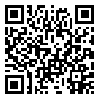Volume 7, Issue 3 (August 2020)
IJML 2020, 7(3): 197-211 |
Back to browse issues page
Effects of Icariin on Histomorphometric Changes of Testis and Prostate Induced by Acrylamide in Mice
Mahsa Doctor Arastoye Marandi 
 , Maryam Yadegari *
, Maryam Yadegari * 

 , Abbas Shahedi
, Abbas Shahedi 

 , Majid Pourentezari
, Majid Pourentezari 

 , Morteza Anvari
, Morteza Anvari 

 , Azadeh Shahrokhi Raeini
, Azadeh Shahrokhi Raeini 

 , Hengameh Dortaj
, Hengameh Dortaj 



 , Maryam Yadegari *
, Maryam Yadegari * 

 , Abbas Shahedi
, Abbas Shahedi 

 , Majid Pourentezari
, Majid Pourentezari 

 , Morteza Anvari
, Morteza Anvari 

 , Azadeh Shahrokhi Raeini
, Azadeh Shahrokhi Raeini 

 , Hengameh Dortaj
, Hengameh Dortaj 


Department of Anatomy and Cell Biology, Faculty of Medicine, Shahid Sadoughi University of Medical Sciences, Yazd, Iran
Abstract: (924 Views)
Background and Aims: This study aimed to observe the effect of Icariin on histomorphometric changes of testis and prostate induced by Acrylamide.
Materials and Methods: Male mice were divided into four groups (n=8): A is the control group and does not get any treatment, B is the sham group and only received drinking water. C group received Acrylamide 10 mg/kg. D group received Acrylamide 15 mg/kg+1.5 mg/kg of Icariin. Histological changes in testis and prostate were examined using stereological methods.
Results: Results showed decreases in testis weight of the group treated by (p≤0.01) and the group cured by Acrylamide +Icariin group (p≤0.05). The total volume of testis showed a reduction in the Acrylamide group compared to other groups (p≤0.05). The total number of spermatogonia and spermatocyte cells in the Acrylamide group showed a decrease in comparison with the other groups (p≤0.05). The total number of spermatid cells in the Acrylamide group indicated a significant reduction in comparison with the control and sham group (p≤0.05). The total number of sertoli cells in the Acrylamide group showed a reduction when the number of leydig cells in the Acrylamide group showed a significant decrease in comparison with the control, sham, and Acrylamide+Icariin groups (p≤0.05). The mean Johnsen score was decreased in the Acrylamide treated group compared to control, sham, and Acrylamide+Icariin groups (p≤0.05). Testosterone concentration in the Acrylamide group showed a reduction in comparison with control, sham, and Acrylamide+Icariin groups (p≤0.05).
Conclusion: Results demonstrated that Acrylamide altered the structure of the testis, prostate gland, and spermatogenesis stage, and Icariin treatment improved these histopathological changes.
Materials and Methods: Male mice were divided into four groups (n=8): A is the control group and does not get any treatment, B is the sham group and only received drinking water. C group received Acrylamide 10 mg/kg. D group received Acrylamide 15 mg/kg+1.5 mg/kg of Icariin. Histological changes in testis and prostate were examined using stereological methods.
Results: Results showed decreases in testis weight of the group treated by (p≤0.01) and the group cured by Acrylamide +Icariin group (p≤0.05). The total volume of testis showed a reduction in the Acrylamide group compared to other groups (p≤0.05). The total number of spermatogonia and spermatocyte cells in the Acrylamide group showed a decrease in comparison with the other groups (p≤0.05). The total number of spermatid cells in the Acrylamide group indicated a significant reduction in comparison with the control and sham group (p≤0.05). The total number of sertoli cells in the Acrylamide group showed a reduction when the number of leydig cells in the Acrylamide group showed a significant decrease in comparison with the control, sham, and Acrylamide+Icariin groups (p≤0.05). The mean Johnsen score was decreased in the Acrylamide treated group compared to control, sham, and Acrylamide+Icariin groups (p≤0.05). Testosterone concentration in the Acrylamide group showed a reduction in comparison with control, sham, and Acrylamide+Icariin groups (p≤0.05).
Conclusion: Results demonstrated that Acrylamide altered the structure of the testis, prostate gland, and spermatogenesis stage, and Icariin treatment improved these histopathological changes.
Type of Study: Research |
Subject:
Pathology
Received: 2020/01/25 | Accepted: 2020/05/15 | Published: 2020/08/27
Received: 2020/01/25 | Accepted: 2020/05/15 | Published: 2020/08/27
| Rights and permissions | |
 |
This work is licensed under a Creative Commons Attribution-NonCommercial 4.0 International License. |

